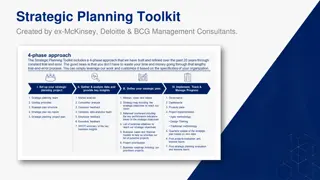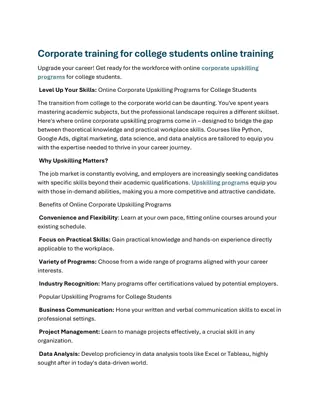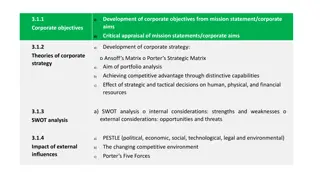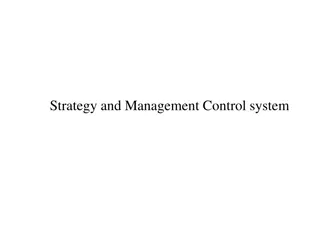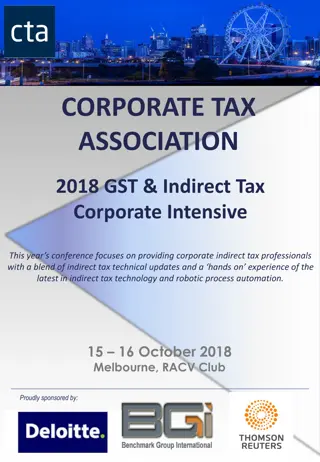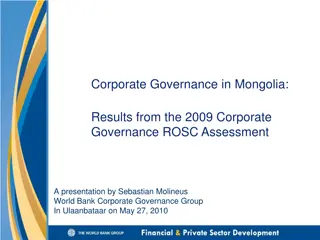
Strategic Decisions and Corporate-Level Strategy
Identify alternative directions for strategy and understand diversification as an effective growth strategy. Learn about value addition and portfolio management in corporate parenting.
Download Presentation

Please find below an Image/Link to download the presentation.
The content on the website is provided AS IS for your information and personal use only. It may not be sold, licensed, or shared on other websites without obtaining consent from the author. If you encounter any issues during the download, it is possible that the publisher has removed the file from their server.
You are allowed to download the files provided on this website for personal or commercial use, subject to the condition that they are used lawfully. All files are the property of their respective owners.
The content on the website is provided AS IS for your information and personal use only. It may not be sold, licensed, or shared on other websites without obtaining consent from the author.
E N D
Presentation Transcript
Strategic Decisions and Strategic Decisions and Corporate Corporate- -Level Strategy Level Strategy 1
Learning Outcomes (1) Identify alternative directions for strategy, including market penetration or consolidation, product development, market development, and diversification Recognise when diversification is an effective strategy for growth Distinguish between different diversification strategies (related and unrelated) and identify conditions under which they work best 2
Learning Outcomes (2) Analyse the ways in which a corporate parent can add or destroy value for its portfolio of business units Analyse portfolios of business units and judge which to invest in and which to divest 3
What is a Corporate Parent? The corporate parent refers to the levels of management above that of the business units, and therefore without direct interaction with buyers and competitors. Small business like a local builder 4
Exhibit 7.1 Strategic Directions and Corporate-Level Strategy Value creation Corporate parenting Portfolio management Penetration Consolidation Development Diversification Scope decisions 6
Exhibit 7.2 Strategic Directions (Ansoff Matrix) 8
What is Market Penetration? Market penetration refers to a strategy by which an organisation takes increased share of its existing markets with its existing product range. Cream Cracker biscuits 9
Constraints of Market Penetration Retaliation from competitors Legal constraints 10
What is Consolidation? Consolidation refers to a strategy by which an organisation focuses defensively on their current markets with current products. 11
Forms of Consolidation Defending market share Downsizing or divestment 12
What is Product Development? Product development refers to a strategy by which an organisation delivers modified or new products to existing markets. Bourbon biscuits
Risks of Product Development Project management risk New strategic capabilities 14
What is Market Development? Market development refers to a strategy by which an organisation offers existing products to new markets. 15
Forms of Market Development New segments New users New geographies 16
What is Diversification? Diversification refers to a strategy by which an organisation pursues new product offerings and new markets. Cam Beer by Lion brewery 17
Reasons for Pursuing Diversification (1) Efficiency gains University Resources Stretching corporate parenting capabilities Increasing market power 19
Reasons for Pursuing Diversification (2) Responding to market decline Kodak Film roll Spreading risk Expectations of powerful stakeholders Enron fate 20
Exhibit 7.3 Related Diversification Options Cargills Bank SMAK water bottles Asiri Health..www.doc.lk
Exhibit 7.4 Diversification and Performance LAUFGS Holdings 1. Power and energy 2. Retail and consumer 3. Industrial 4. Leisure 5. Logistics 6. Property and real estate 22
Value-Adding Activities Coaching and facilitating Envisioning Providing central services and resources Intervening 23
Value-Destroying Activities Adding management costs Adding bureaucratic complexity Obscuring financial performance 24
Exhibit 7.5 Portfolio and Synergy Managers and Parental Developers 25
Problems Achieving Synergy Excessive costs Overcoming self-interest Illusory synergies 27
Challenges for Parental Developers Identifying parent capabilities Parental focus The crown jewel problem Sufficient feel 28
Portfolio Matrices Growth/Share (BCG) Matrix Directional Policy (GE-McKinsey) Matrix Parenting Matrix 29
Exhibit 7.7 The Growth Share (BCG) Matrix 30
Exhibit 7.8 The Directional Policy (GE-McKinsey) Matrix 31
Exhibit 7.9 Strategy Guidelines Based on Directional Policy Matrix 32

